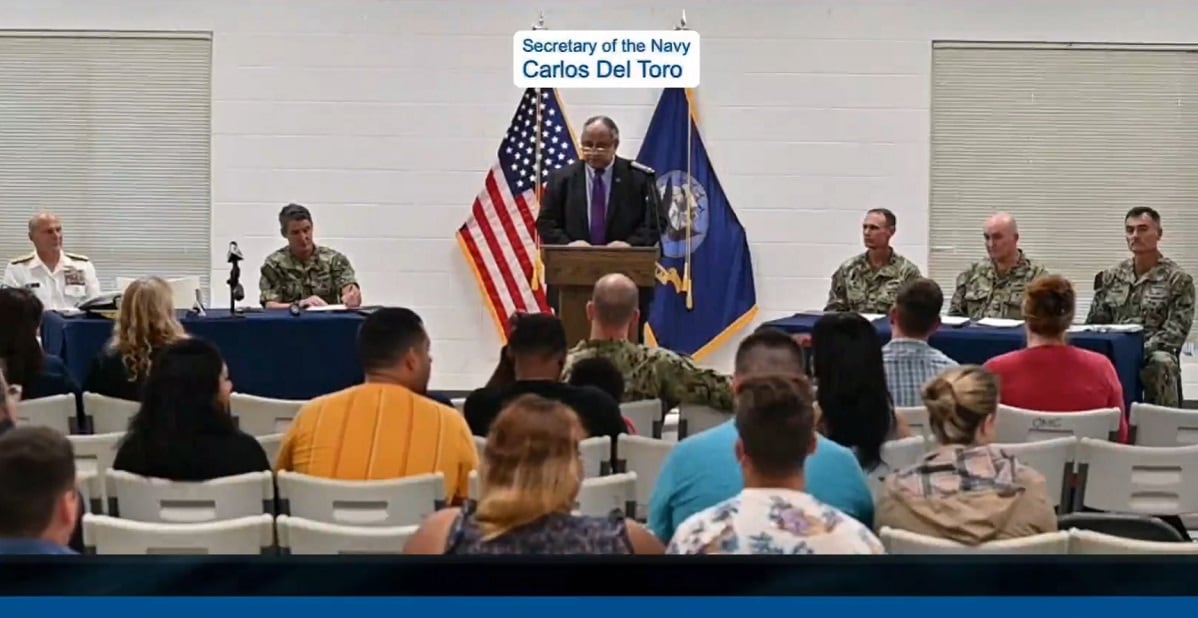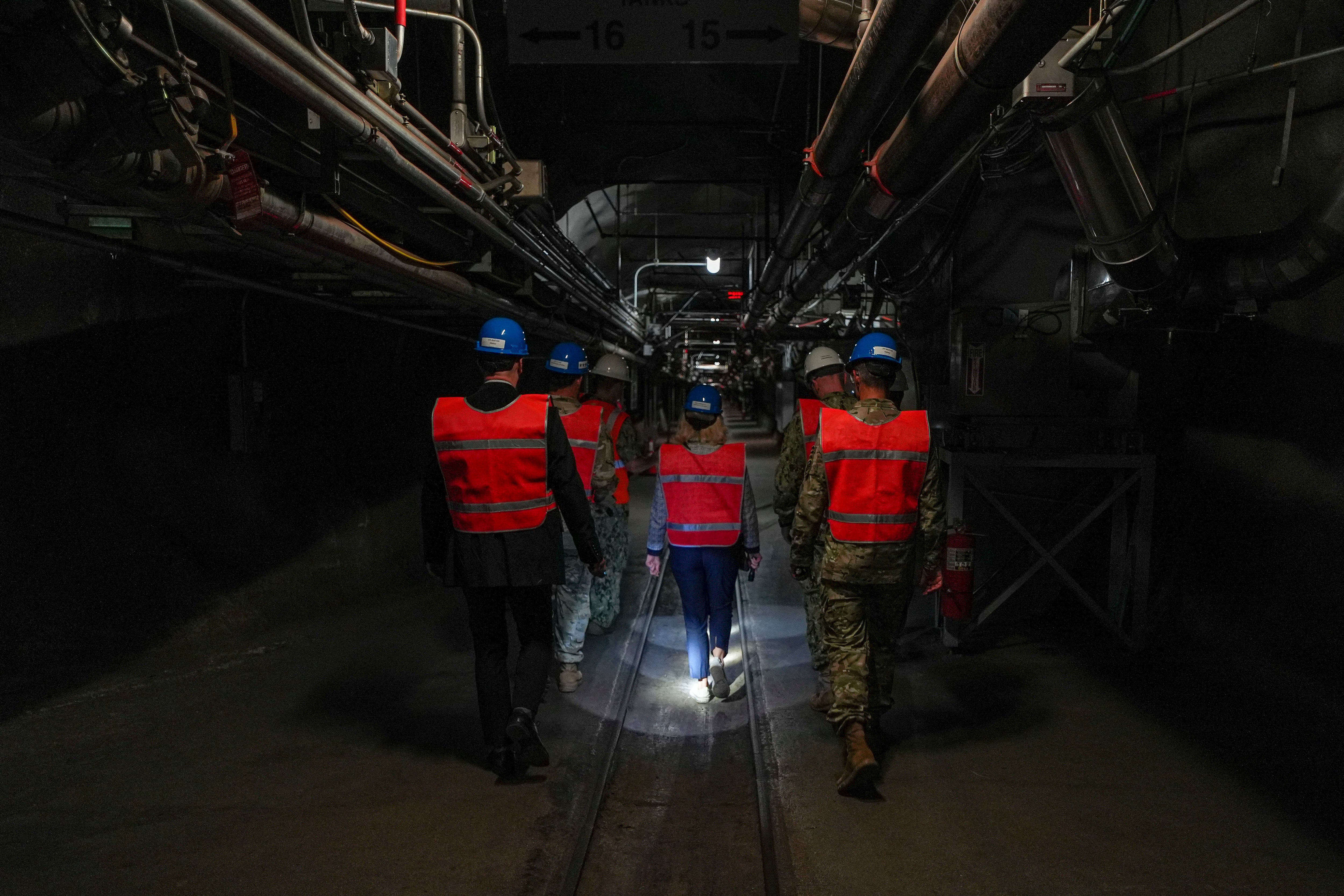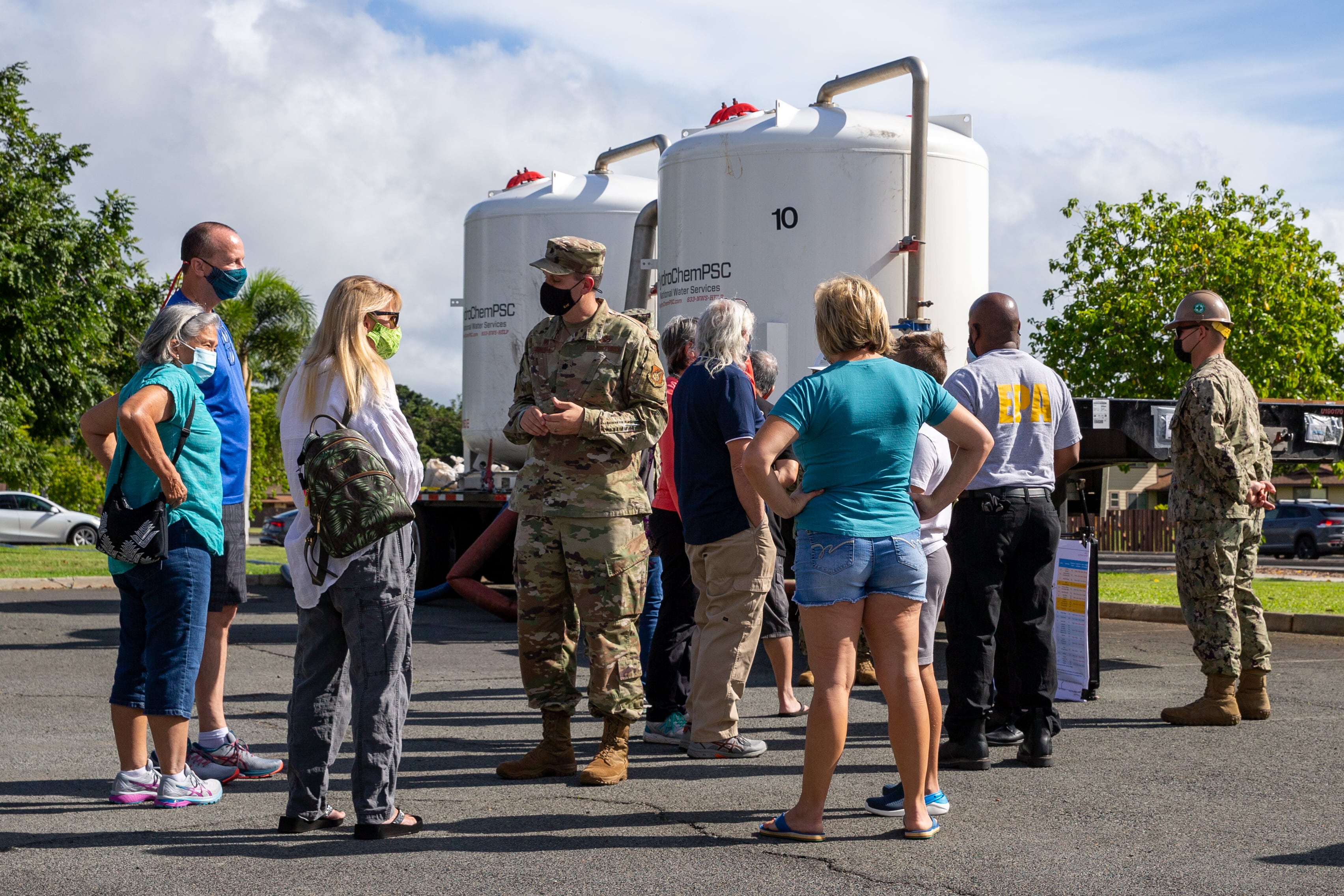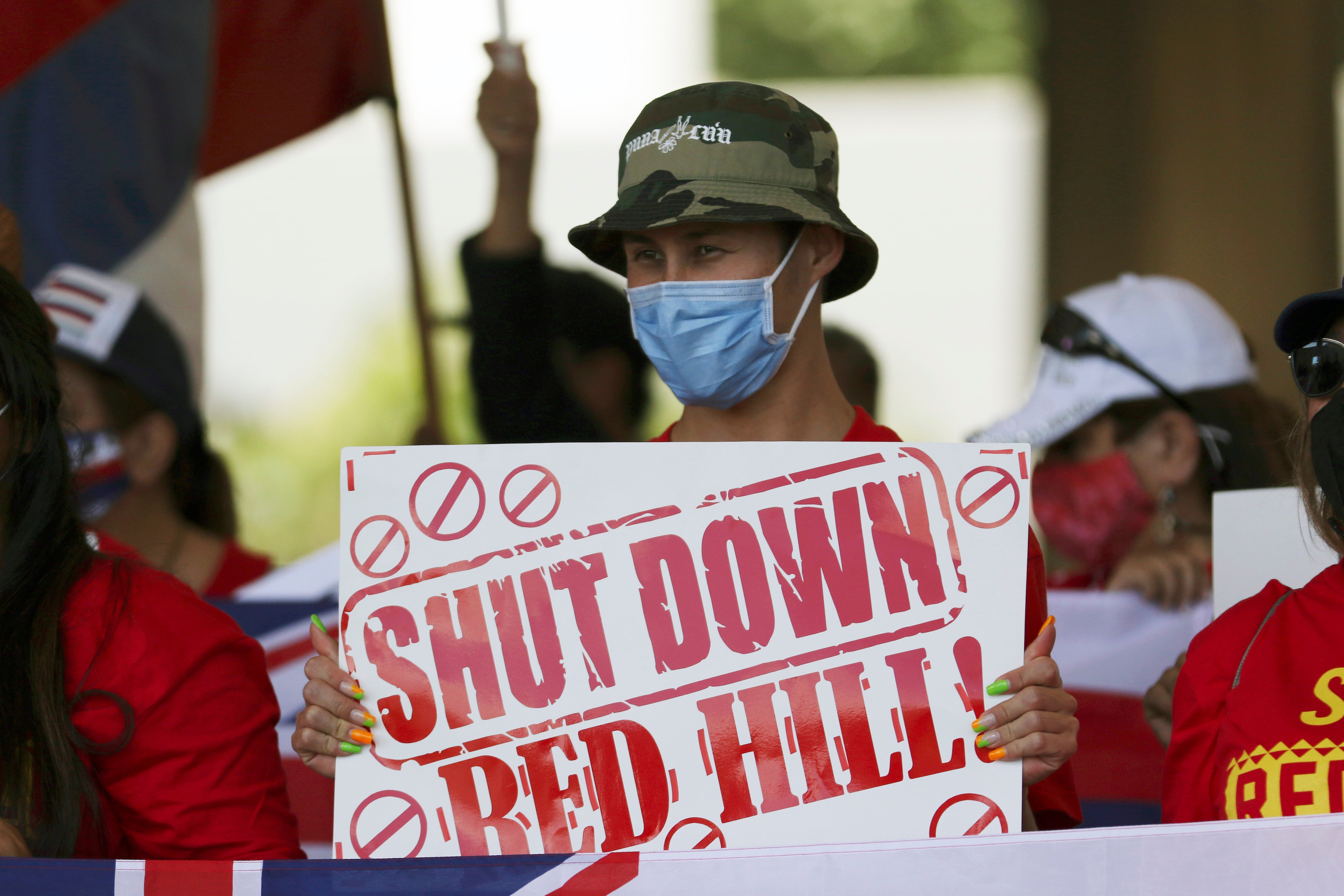The fuel spill at the U.S. Navy’s Red Hill facility changed everything for the Feindt family.
After petroleum seeped into their drinking water on Pearl Harbor’s Ford Island in 2021, Army Maj. Amanda Feindt, her husband Patrick and their two young children got severely ill, they said in court records.
Amanda and Patrick suffered from gastrointestinal issues, vertigo and lethargy. Their 3-year-old daughter Palmer experienced rashes, shortness of breath and developmental regression. Their 1-year-old son Trip developed a bad cough and wheezing.
They were displaced from their home, relocated multiple times to hotels to avoid the toxic exposure and ultimately moved off the island. More than two years after the disaster, the entire family is still struggling with health problems, according to a pretrial brief.
The Feindts are now at the center of a massive lawsuit against the federal government that is set to go to trial next week. The case seeks to hold the military accountable for contaminating the water 93,000 people relied on for drinking, bathing and doing laundry, a disaster that sickened thousands and prompted the planned shutdown of the historic Red Hill facility.
The case, which includes more than 7,500 claimants, faults the Navy for tainting the water with jet fuel and seeks compensatory damages, including for pain and suffering, medical care, lost income and emotional distress.
For the Feindts, the case is about starting to repair their sense of betrayal.
“It’s accountability,” Amanda Feindt said in an interview. “As a service member, I care deeply about this because it’s my institution that poisoned these people. As the one who still wears the uniform, I believe in our core values that people are our greatest asset, and we have an obligation to care for people, especially when they’re harmed. That did not happen.”
RELATED

Headed by attorneys Kristina Baehr, Lyle Hosoda and Frederick Baker, the case is the first of its kind to go to trial since the 2021 disaster.
And in a sense, the plaintiffs have already won. The federal government admitted early on that it negligently breached its duty to its water customers and caused a nuisance that impacted their lives.
The question before the court now, in a trial starting Monday, is how much that harm is worth.
The answer will be determined by U.S. District Court Judge Leslie Kobayashi. There will be no jury and no direct questioning of witnesses. Lawyers have already submitted thousands of pages of documents — depositions, declarations, exhibits — for Kobayashi’s review.
The U.S. Department of Justice has argued that there are many potential causes of the symptoms that Red Hill families suffered and questioned whether they were exposed to jet fuel at all or long enough to cause their maladies.
The judge will assess the evidence and will only hear from certain witnesses, namely those whom the DOJ wants to cross-examine. In those cases, the plaintiffs’ attorneys will have an opportunity to ask follow-up questions.
Overall, the trial is expected to last around 10 days.
Lawsuit details physical and emotional trauma
The crisis at Red Hill stems from back-to-back fuel leaks at the Navy’s World War II-era fuel depot.
In May 2021, a pipeline burst, releasing some 20,000 gallons of fuel into a tunnel in the underground facility. The Navy failed to account for all the released fuel, most of which was sucked up by a fire suppression drain line. Months later, in November, that “missing” fuel was discovered in a different part of the facility when a worker hit the drain line’s valve with a cart, sending fuel spewing once again into a tunnel.

This time, the location of the spill was less than 400 feet from the Red Hill well, which provided water to neighborhoods, businesses and military buildings around Pearl Harbor.
Despite that proximity, the Navy did not immediately shutter the well or warn water customers the water might be unsafe. They only did so after a wave of complaints from residents over the Thanksgiving weekend that they were getting sick and their water smelled.
For days, the Navy insisted there were no indications the water was unsafe. Meanwhile, families continued to drink the water and use it to bathe, wash dishes and do laundry.
“At every turn, the Navy reassured the public rather than warn them,” the plaintiffs’ trial brief says.
The lawsuit cites six families — called bellwether plaintiffs — who were all living on the Navy water line at the time of the crisis and experienced a range of health symptoms.
Kevin Aubert, a veteran who lived in the Doris Miller Park neighborhood, suffered from rashes, eye irritations, joint and abdominal pain, headaches and fatigue, according to the lawsuit. His toy poodle, Coco, experienced several seizures. The incident has caused longterm mental health challenges and emotional distress, the suit claims, with Aubert fearing he may one day develop cancer from his exposure.
The Dietz family, residents of the Earhart Village neighborhood in 2021, initially thought they’d gotten food poisoning from Thanksgiving dinner. Then they noticed a fuel smell and a sheen on their water, according to the lawsuit. The family, including their children, then ages 5 and 13, experienced stomach pain, rashes, “splitting headaches,” burning in their throat and neurological symptoms, the lawsuit states.
For Nastasia Freeman of the Aliamanu Military Reservation, the fuel-tainted water reignited a previously controlled seizure disorder, the lawsuit says. Beau Jessup, who lived in Radford Terrace with his family, developed a lingering hand tremor that “threatens to end his dreams of serving in the military,” the lawsuit states. And contamination activated severe anxiety, in addition to physical symptoms, for Elizabeth Witt, the wife of an Air Force captain, according to the lawsuit.
Some of the plaintiffs have symptoms consistent with post-traumatic stress disorder, according to a plaintiffs’ witness.
Monetary rewards will likely be based on the severity of the bellwether plaintiffs’ experiences. Thousands of additional claimants may then be categorized, and awarded, comparably.
Baehr declined to comment for this story. The DOJ did not respond to a request for comment.
Despite its admission of negligence, the Department of Justice disputes some of the basic facts of the case. One point it plans to challenge is whether the plaintiffs were even exposed to jet fuel, and if so, whether the dose and duration were enough to make them sick.
“Most of the health effects claimed by the Plaintiffs are common and have multiple potential causes,” government witness Robyn Prueitt, a toxicologist, stated in a declaration.
The DOJ’s contention is contradicted by one of their own: Dr. John Oh, the Defense Health Agency’s chief for occupational and environmental health division, who said during a deposition that people were exposed to enough fuel — by drinking it, smelling it and being exposed through the skin — to get sick.
“I think that clearly the better course of action would not be to have any exposure to the water,” Oh said under oath.

Nevertheless, the government is asking the court to find the plaintiff’s exposure to jet fuel — if there was any — did not make them sick and that the government is not liable for any future medical or psychological expenses.
The DOJ argues residents were only exposed to jet fuel over a matter of days and may have experienced symptoms due to stress or perceptions about the fuel smell coming from their water. One government witness alleged the plaintiffs’ symptoms could be “somatic.”
“The United States does not deny that the Bellwethers — to varying degrees — were distressed, were inconvenienced, and, for some, may have experienced short-term health effects from the November 2021 spill,” government lawyers said in a trial brief.
“That does not mean, however, that the Court must accept the Bellwethers’ rendition of damages.”
Any award to the plaintiffs should account for the government’s efforts to mitigate the contamination, the DOJ argued, including providing bottled water and putting people up in hotels. And attorneys noted many of the impacted families’ medical costs are already covered by the military health care system.
Red Hill whistleblower will not be heard
The DOJ has also sought to significantly limit the scope of the case.
The trial will pertain only to injuries sustained after November 2021. Although some residents have reported illnesses that began prior to that date, those won’t be addressed in this trial. In an effort to secure a speedy trial, the plaintiffs agreed to that.
In other instances, plaintiffs wanted to include information Kobayashi ruled will be excluded from her consideration.
Lt. Cmdr. Shannon Bencs, a former fuel director at Red Hill who became a whistleblower, had sought to provide testimony and documents to support plaintiffs’ claims that the Navy was negligent in the leadup to the fuel leaks.
In a court filing, the DOJ said hearing from Bencs and other witnesses about pre-November 2021 events would be a “waste of time” because the government has already admitted fault. Ultimately, the judge agreed. Kobayashi told the parties on Tuesday she will not review prior testimony from Bencs, who sat for a deposition, and will not allow her to testify live at the trial.
Bencs took over as the fuel director in 2020, less than a year before the May leaks. Almost immediately, she said in a deposition, she realized the facility was poorly maintained and leadership was not following proper protocols.
In a deposition, she testified that when she raised concerns, she was sidelined from her fuel director duties and later removed from her position. Bencs said she recognized Red Hill as a “ticking time bomb” but said no one heeded her warnings.
“I absolutely believe this whole thing was preventable,” she testified.
Since Bencs was deposed, a case she filed in federal court has been unsealed. Her complaint shows she was concerned Red Hill contractors were cutting corners on maintenance and repairs even as they collected millions of dollars in contract awards.
I absolutely believe this while thing was preventable.
— Navy Lt. Cmdr. Shannon Bencs, former fuel director at Red Hill
Bencs was initially on the plaintiffs’ witness list, and Baehr’s team had hoped to question her directly in court.
“She has unique and credible testimony to aid the Court in adjudicating the remaining issues in dispute in this case — particularly foreseeability and the Government’s failure to warn of a known hazard,” the plaintiffs’ attorneys argued in a briefing.
In a letter to Judge Kobayashi sent earlier this month, Bencs said she had information relevant to the case that was not covered in her deposition, and she has “documents, recordings, videos, photos and other files” that she has preserved but were never collected by DOJ for discovery in the case.
“I am providing this information to officially disclose to the court all additional information that is relevant to the safety and health of the citizens of Oahu as I do not want it to be covered up and dismissed,” Bencs wrote.
But Kobayashi declined to review the material, and on Tuesday, the judge ruled that since the government has already admitted to negligence, evidence supporting a negligence argument is “irrelevant.”
RELATED

Kobayashi also will not consider arguments regarding future medical damages, such as pain and suffering, physical impairment, loss of quality of life, increased risk of harm or loss of life expectancy. She ruled plaintiffs do not have “the requisite expert epidemiological testimony necessary” to support such a claim.
However, she will consider evidence demonstrating a need for future psychological care.
Whatever happens, Feindt said she is grateful for the opportunity for her family and neighbors to have their day in court.
“Folks get to tell their story,” she said. “This isn’t going to be swept under the rug.”
This article originally appeared in Honolulu Civil Beat at civilbeat.org.




